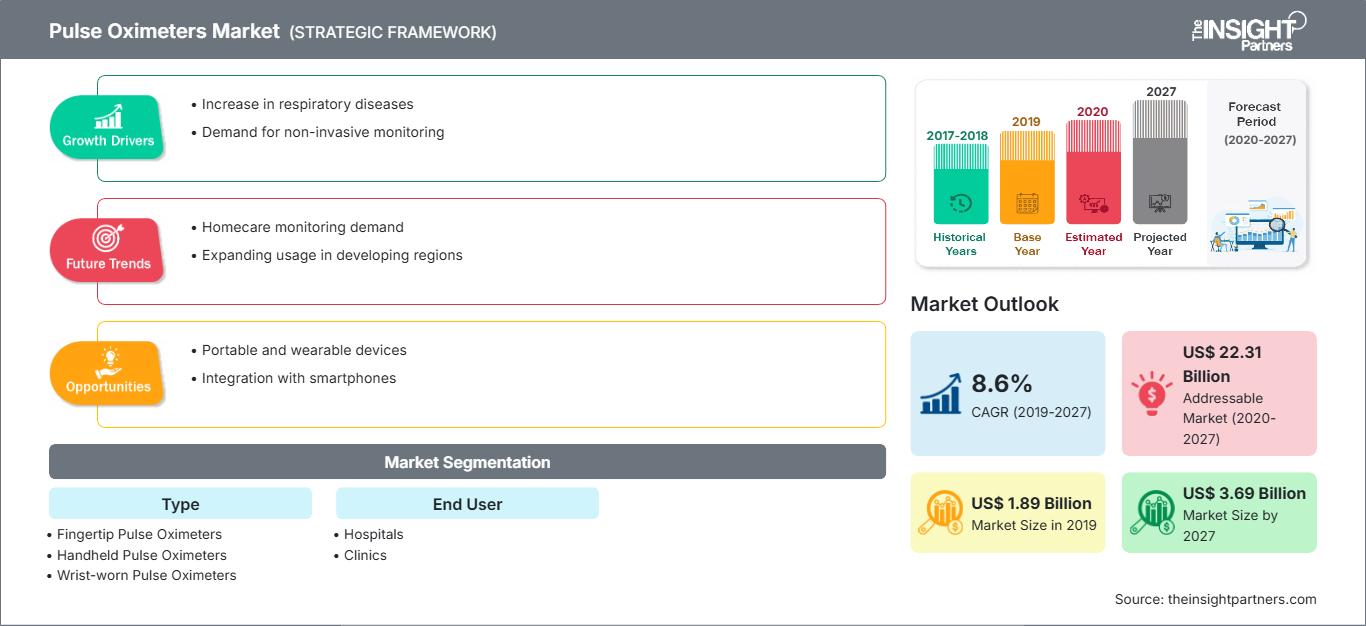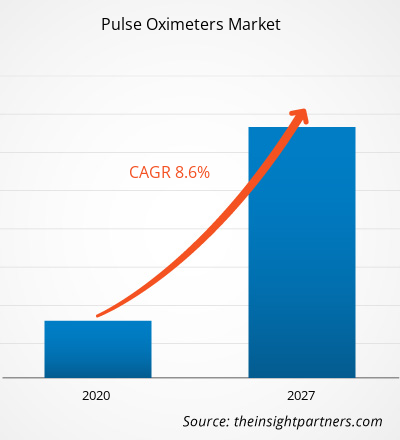Der Markt für Pulsoximeter hatte 2019 einen Wert von 1.892,00 Millionen US-Dollar und soll bis 2027 voraussichtlich 3.693,92 Millionen US-Dollar erreichen; für den Zeitraum 2020–2027 wird ein durchschnittliches jährliches Wachstum von 8,6 % erwartet.
Ein Pulsoximeter ist ein nicht-invasives Gerät zur Überwachung der Sauerstoffsättigung im Blut. Es handelt sich um ein kleines, klammerartiges Gerät, das am Finger oder Ohrläppchen befestigt wird. Es wird hauptsächlich in der Intensivmedizin, bei Operationen, in der Notfallversorgung und bei Patienten in großen Höhen eingesetzt, um die Sauerstoffsättigung des Patienten zu beurteilen und festzustellen, ob zusätzlicher Sauerstoff benötigt wird. Darüber hinaus sind Pulsoximeter für Patienten mit Herzproblemen, Atemproblemen und chronisch obstruktiven Lungenerkrankungen nützlich.
Markteinblicke: Zunehmende Prävalenz von Atemwegserkrankungen treibt Marktwachstum an
Die zunehmende Prävalenz von Atemwegserkrankungen hängt mit der Verringerung der Größe des Lumens der oberen Atemwege mit zunehmendem Alter der Menschen zusammen. Ein großer Prozentsatz der Bevölkerung weltweit leidet an verschiedenen Arten von Atemwegserkrankungen. Rauchen, genetische Faktoren und Infektionen gehören zu den häufigsten Faktoren, die Atemwegserkrankungen verursachen. Chronisch obstruktive Lungenerkrankung (COPD), Schlafapnoe, Herzrhythmusstörungen, ischämische Zustände, Diabetes, Bluthochdruck und Asthma gehören zu den Erkrankungen, die das öffentliche Gesundheitssystem in vielen Ländern erheblich belasten. Laut der American Lung Association ist COPD die dritthäufigste Todesursache in den USA, wo mehr als 16,4 Millionen Menschen mit dieser Krankheit diagnostiziert werden. Darüber hinaus litten laut dem US-Gesundheitsministerium im Jahr 2019 rund 25 Millionen Menschen in den USA an Asthma, einer der weltweit häufigsten Atemwegserkrankungen. Patienten mit diesen Atemwegserkrankungen leiden häufig unter Atembeschwerden und Sauerstoffmangel. Ein Pulsoximeter bietet eine nicht-invasive und sichere Methode zur Messung der Sauerstoffsättigung.
Die weltweit steigende Zahl der COVID-19-Fälle treibt auch die Nachfrage nach Pulsoximetern an. Die kontinuierliche Überwachung der Atemparameter ist einer der wichtigsten Schritte in der Behandlung von COVID-19-Patienten. Daher sind medizinische Fachkräfte für die genaue Überwachung und Behandlung von COVID-19-Fällen auf Pulsoximeter und andere Multiparameter-Monitore angewiesen. Darüber hinaus werden verschiedene Arten von Pulsoximetern häufig zur routinemäßigen Überwachung zu Hause eingesetzt.
Passen Sie diesen Bericht Ihren Anforderungen an
Sie erhalten kostenlos Anpassungen an jedem Bericht, einschließlich Teilen dieses Berichts oder einer Analyse auf Länderebene, eines Excel-Datenpakets sowie tolle Angebote und Rabatte für Start-ups und Universitäten.
Markt für Pulsoximeter: Strategische Einblicke

- Holen Sie sich die wichtigsten Markttrends aus diesem Bericht.Dieses KOSTENLOSE Beispiel umfasst Datenanalysen, die von Markttrends bis hin zu Schätzungen und Prognosen reichen.
Produkteinblick
Sie erhalten kostenlos Anpassungen an jedem Bericht, einschließlich Teilen dieses Berichts oder einer Analyse auf Länderebene, eines Excel-Datenpakets sowie tolle Angebote und Rabatte für Start-ups und Universitäten.
Markt für Pulsoximeter: Strategische Einblicke

- Holen Sie sich die wichtigsten Markttrends aus diesem Bericht.Dieses KOSTENLOSE Beispiel umfasst Datenanalysen, die von Markttrends bis hin zu Schätzungen und Prognosen reichen.
Nach Typ hatte das Segment der Fingerpulsoximeter 2019 den größten Anteil am Pulsoximetermarkt und wird seine Dominanz voraussichtlich fortsetzen und im Prognosezeitraum eine höhere CAGR auf dem Markt verzeichnen.
Einblicke in Sensortypen
Basierend auf dem Sensortyp ist der globale Markt für Pulsoximeter in wiederverwendbare und Einwegsensoren segmentiert. Das Segment der wiederverwendbaren Sensoren hatte 2019 den größten Marktanteil und wird im Prognosezeitraum voraussichtlich die höchste CAGR verzeichnen. Das Wachstum ist auf die steigende Zahl von COVID-19-Patienten weltweit zurückzuführen.
Einblicke in Endbenutzer
Basierend auf dem Endbenutzer ist der globale Markt für Pulsoximeter in Krankenhäuser, Kliniken und andere segmentiert. Das Kliniksegment hatte 2019 den größten Marktanteil, und andere Segmente werden im Prognosezeitraum voraussichtlich die höchste durchschnittliche jährliche Wachstumsrate verzeichnen.
Ein Pulsoximeter ist ein kleines, leichtes Gerät zur Überwachung der Sauerstoffmenge im Körper. Fingerpulsoximeter sind nicht-invasiv, benutzerfreundlich und kompakt, was sie zu einer bevorzugten Option für Säuglinge und Neugeborene macht. Es wird an der Fingerspitze befestigt und sendet Licht zwei Wellenlängen, um die Pulsfrequenz und den Sauerstoffgehalt zu messen. Nach Abschluss der Messung zeigt das Display den Sauerstoffanteil in Prozent und die aktuelle Pulsfrequenz an. Menschen mit Herz- oder Atemproblemen sind auf Fingerpulsoximeter angewiesen, die ihnen bei der Behandlung dieser Erkrankungen helfen. Asthmapatienten können beispielsweise mithilfe von Oximetern die Schwere ihrer Anfälle einschätzen. Laut CDC leiden in den USA rund 19,2 Millionen Erwachsene an Asthma. Genaue Pulsfrequenz- und SpO2-Messwerte sind besonders wichtig für Patienten, bei denen der Sauerstoffgehalt häufig abfällt.
Akteure auf dem Markt für Pulsoximeter verfolgen Kooperations- und Partnerschaftsstrategien, um die Anforderungen der Endbenutzer durch die Einführung technologisch fortschrittlicher Angebote zu erfüllen, und diese Strategien unterstützen das Wachstum des Marktes erheblich.
PulsoximeterRegionale Einblicke in den Markt für Pulsoximeter
Die Analysten von The Insight Partners haben die regionalen Trends und Faktoren, die den Markt für Pulsoximeter im Prognosezeitraum beeinflussen, ausführlich erläutert. In diesem Abschnitt werden auch die Marktsegmente und die geografische Lage in Nordamerika, Europa, dem asiatisch-pazifischen Raum, dem Nahen Osten und Afrika sowie Süd- und Mittelamerika erörtert.
Umfang des Marktberichts zu Pulsoximetern
| Berichtsattribut | Einzelheiten |
|---|---|
| Marktgröße in 2019 | US$ 1.89 Billion |
| Marktgröße nach 2027 | US$ 3.69 Billion |
| Globale CAGR (2019 - 2027) | 8.6% |
| Historische Daten | 2017-2018 |
| Prognosezeitraum | 2020-2027 |
| Abgedeckte Segmente |
By Typ
|
| Abgedeckte Regionen und Länder | Nordamerika
|
| Marktführer und wichtige Unternehmensprofile |
|
Marktdichte von Pulsoximetern: Auswirkungen auf die Geschäftsdynamik verstehen
Der Markt für Pulsoximeter wächst rasant. Die steigende Nachfrage der Endverbraucher ist auf Faktoren wie veränderte Verbraucherpräferenzen, technologische Fortschritte und ein stärkeres Bewusstsein für die Produktvorteile zurückzuführen. Mit der steigenden Nachfrage erweitern Unternehmen ihr Angebot, entwickeln Innovationen, um den Bedürfnissen der Verbraucher gerecht zu werden, und nutzen neue Trends, was das Marktwachstum weiter ankurbelt.

- Holen Sie sich die Markt für Pulsoximeter Übersicht der wichtigsten Akteure
- Fingerspitzen-Pulsoximeter
- Hand-Pulsoximeter
- Am Handgelenk getragene Pulsoximeter
- Pulsoximeter für Kinder
Nach Sensortyp
- Wiederverwendbar
- Einweg
Nach Ende Benutzer
- Krankenhäuser
- Kliniken
- Andere
Nach Geografie
Norden Amerika
- USA
- Kanada
- Mexiko
Europa
- Frankreich
- Deutschland
- Italien
- Großbritannien
- Russland
Asien-Pazifik
- China
- Indien
- Südkorea
- Japan
- Australien
Naher Osten und Afrika
- Südafrika
- Saudi-Arabien
- VAE
Süd- und Mittelamerika
- Brasilien
- Argentinien
Unternehmen Profile
- Nonin
- Koninklijke Philips NV
- VYAIRE MEDICAL, INC.
- Smiths Medical
- Hill Rom Holding Inc.
- Edwards Lifesciences Corporation
- Medtronic
- Masimo
- Beurer GmbH
- Maxtec
- Historische Analyse (2 Jahre), Basisjahr, Prognose (7 Jahre) mit CAGR
- PEST- und SWOT-Analyse
- Marktgröße Wert/Volumen – Global, Regional, Land
- Branchen- und Wettbewerbslandschaft
- Excel-Datensatz
Aktuelle Berichte
Erfahrungsberichte
Grund zum Kauf
- Fundierte Entscheidungsfindung
- Marktdynamik verstehen
- Wettbewerbsanalyse
- Kundeneinblicke
- Marktprognosen
- Risikominimierung
- Strategische Planung
- Investitionsbegründung
- Identifizierung neuer Märkte
- Verbesserung von Marketingstrategien
- Steigerung der Betriebseffizienz
- Anpassung an regulatorische Trends




















 Kostenlose Probe anfordern für - Markt für Pulsoximeter
Kostenlose Probe anfordern für - Markt für Pulsoximeter